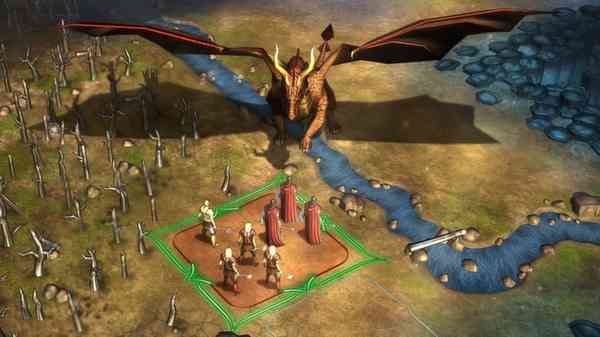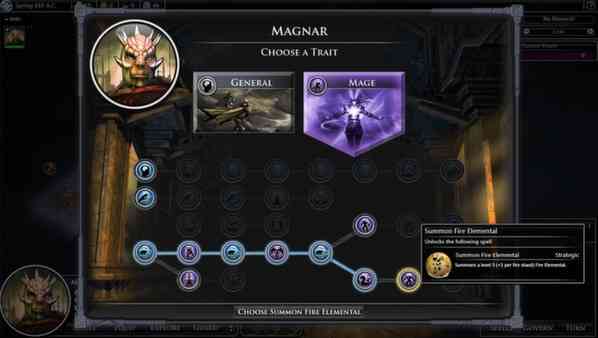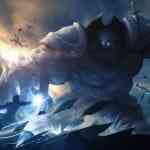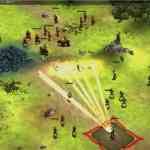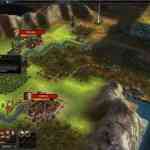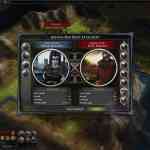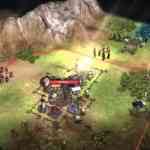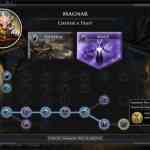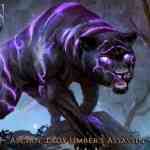Late last year I covered an ambitious title that managed to cover several types of game genres, including RTS, action, and RPG. The game was called “Elemental: Fallen Enchantress” by Stardock. It showed a lot of potential but at the time I felt it was a bit rushed and well unpolished. Fast-forward to today, and its freshly-released standalone expansion. Does this game improve over its previous entry? Read on to find out.
After starting up the game you are greeted with a customary menu giving you the options to either play a custom single player game, a scenario mode, or view tutorials. Single player games will let you build your own character (or use pre-made characters) and setup custom maps to begin your adventures on, while scenario mode will automatically give you a character, a bit of a background story and start you off on a preset map.
The single player experience is still the meat and potatoes of the game. You have more options this time around in terms of how to craft your character than in the first game. Stardock has added a lot of skills and skill trees to choose from as your character develops. I found myself redoing a character over and over until I made one that suited my play style.
Once you complete your character’s creation (or choose a premade one) you are given the chance to set up the world map to your liking; with options such as size, difficulty, quest frequency, monster frequency and dozens more. Then you get to the part where you set up the opposition you will face. You can make your upcoming game a challenge or a cakewalk – it’s all up to you. There are even winning condition options when battling away on the map. You can win the map either by conquest, diplomatic means, completing the “master quest”, or performing “The spell of making”. Conquest is basically defeating all your opponents on the map, Diplomatic is forming an alliance with every other faction available, Master Quest requires you to find and complete a hidden special quest somewhere on the map, and The Spell of Making is winning with a magic victory. This is done through research, and takes time and control of multiple shards found on map.
With all the options set, you are good to go and placed on the map randomly. The first thing you need to do, as in the last game, is place your castle. Once your castle is built (which is pretty much instantaneous) you can build add-ons to it, such as merchants, towers, and monuments, which will benefit your kingdom with gold, fame, and faster research of new skills. It will take time for these to be fully built onto your castle, which is indicated by the number of turns (or as the game calls it, “seasons”) remaining. This also goes for training new troops that you will use to explore the map with.
Once you reach the point in the game where your city is big enough, you are given more choices on how to form your kingdom. You can either turn it into a Conclave, which focuses more on research and studies, a Fortress that specializes in all things military, or a Town which is great for bringing in financial gains and agriculture. I found this to be a major turning point in the game, and can really make it or break it depending on how the map is set up and what your computer controller opponents are doing.
Another thing that will really affect your game is your research of new skills. Research groups are: Civilization, for your governmental and financial needs; Warfare, for new skills for your troops and warrior types; and Magic, for spells to assist your kingdom and aid your wizards. You can research only one skill at a time, and each takes a certain amount of seasons before they are usable. This requires a lot of planning ahead, because you don’t want to get caught unprepared if you are attacked because you decided to focus everything on growing crops instead of training troops. It’s a delicate balancing act, and I really like that in a game – and it works well here.
After all that, you are ready to take your sovereign and some troops (if you have them) out into the world and explore. The first thing that I noticed was that the graphics engine for the game had markedly improved over the original game, which made movement on the map a lot nicer. The map starts out darkened out with just some hints of what might be lurking nearby, but as you move things are revealed, such as possible treasure, quests which can reward you with equipment, new characters for you to use, hostile opponents, and resources for your kingdom. If the base game doesn’t offer enough, there is also DLC available that adds more quests and maps to the mix for a good price.
As in the previous game, everything is turned based, so you can only move so far at one time. It may sound tedious, but the action flows nicely and you don’t have to wait that long between turns. As you explore and battle the enemies you come across, you and your troops will gain experience. When your character levels up enough he is presented with five new possible career paths which are the assassin, defender, commander, mage, and warrior. All these new careers have large skill trees to explore to make your main character unique.
In the previous game you would stumble across champions on the field who you could ask to join your kingdom. That has changed now, so they will instead seek you out depending on how much fame your kingdom has. Fame is earned based on the size of your kingdom, certain adds-ons to your castle, and by defeating enemies. Champions normally approach you in pairs where you can choose one or the other. They are usually pretty different from one another, so choose wisely to what will round out your army. These new champions will also get offered these new career paths as they gain experience.
The battle system in the game has not changed too much. When engaging a hostile foe you have the option to either auto-resolve the conflict – where stats will really come into play to determine the outcome, or battle for yourself. The hand-to-hand combat is still similar to the first game, where you move your characters one at a time. What seems to be new is that it now shows on one side of the screen what order players and opponents will be moving. Similar turn based games have used this, and I found it came in very handy to plan ahead if one particular enemy is going to give me problems.
I should note that I did have a few technical issues. For some reason at first the game would not launch correctly and I had to seek out help from Stardock. However, they provided a fix quickly and I was grateful to them. I also had the game crash on a few occasions, but it seemed random because I could not get it to crash again doing the same thing again. One of the technical problems I came up against involved having to disable a certain file used to smooth the games fonts. As a result, I did find some of the text hard to read at times. However, this is unlikely to affect everyone and I’m certain Stardock will find a work-around shortly for all players.
The look of the game looks is very similar to the first game, until you get to the map you want to play on. I found the graphics a lot more detailed and colourful when it came to the map and its inhabitants this time around. Enemies are well animated, and the larger major boss-type characters that you come across when exploring are really impressive and somewhat intimidating to look at. I would have liked to have seen a bit of an upgrade to the character creation screen – it just seems rather stiff to me.
For those who like to get creative the game offers a Workshop mode where you can create new tiles for the maps, new factions that you can build from the ground up, and even create/alter existing spell effects. When exploring the maps you will be accompanied by a light majestic tune. Combat offers a more of upbeat tone – I’m pretty sure this is the same music from the first game. It is serviceable, but I do wish there was a bit more variety. Sound effects for all the enemies, combat and other interactions work well but nothing to get excited over.
In the end, Fallen Enchantress: Legendary Heroes is certainly an improvement over its predecessor. By no means is it a perfect game as some of the technical issues did cast a shadow over the experience to a degree. That said, Stardock has been hard at work ironing out the wrinkles and the positives far outweigh the negatives. At the end of the day, Fallen Enchantress: Legendary Heroes is a pretty good standalone expansion featuring plenty of variety and replayability.
